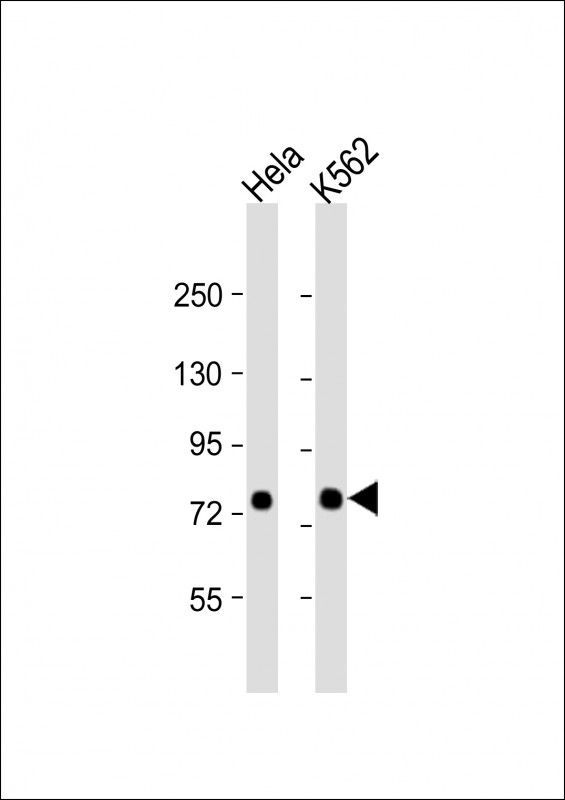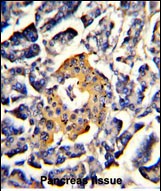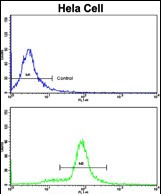SRP72 Antibody (Center)
Affinity Purified Rabbit Polyclonal Antibody (Pab)
- SPECIFICATION
- CITATIONS
- PROTOCOLS
- BACKGROUND

Application
| WB, IF, IHC-P, FC, E |
|---|---|
| Primary Accession | O76094 |
| Reactivity | Human |
| Host | Rabbit |
| Clonality | Polyclonal |
| Isotype | Rabbit IgG |
| Calculated MW | 74606 Da |
| Antigen Region | 119-148 aa |
| Gene ID | 6731 |
|---|---|
| Other Names | Signal recognition particle subunit SRP72, SRP72, Signal recognition particle 72 kDa protein, SRP72 |
| Target/Specificity | This SRP72 antibody is generated from rabbits immunized with a KLH conjugated synthetic peptide between 119-148 amino acids from the Central region of human SRP72. |
| Dilution | IF~~1:10~50 WB~~1:1000 IHC-P~~1:50~100 FC~~1:10~50 |
| Format | Purified polyclonal antibody supplied in PBS with 0.09% (W/V) sodium azide. This antibody is purified through a protein A column, followed by peptide affinity purification. |
| Storage | Maintain refrigerated at 2-8°C for up to 2 weeks. For long term storage store at -20°C in small aliquots to prevent freeze-thaw cycles. |
| Precautions | SRP72 Antibody (Center) is for research use only and not for use in diagnostic or therapeutic procedures. |
| Name | SRP72 |
|---|---|
| Function | Component of the signal recognition particle (SRP) complex, a ribonucleoprotein complex that mediates the cotranslational targeting of secretory and membrane proteins to the endoplasmic reticulum (ER) (PubMed:34020957). The SRP complex interacts with the signal sequence in nascent secretory and membrane proteins and directs them to the membrane of the ER (PubMed:34020957). The SRP complex targets the ribosome-nascent chain complex to the SRP receptor (SR), which is anchored in the ER, where SR compaction and GTPase rearrangement drive cotranslational protein translocation into the ER (PubMed:34020957). Binds the signal recognition particle RNA (7SL RNA) in presence of SRP68 (PubMed:21073748, PubMed:27899666). Can bind 7SL RNA with low affinity (PubMed:21073748, PubMed:27899666). The SRP complex possibly participates in the elongation arrest function (By similarity). |
| Cellular Location | Cytoplasm. Endoplasmic reticulum |

Thousands of laboratories across the world have published research that depended on the performance of antibodies from Abcepta to advance their research. Check out links to articles that cite our products in major peer-reviewed journals, organized by research category.
info@abcepta.com, and receive a free "I Love Antibodies" mug.
Provided below are standard protocols that you may find useful for product applications.
Background
Signal-recognition-particle assembly has a crucial role in targeting secretory proteins to the rough endoplasmic reticulum membrane. It binds the 7S RNA only in presence of SRP68. This ribonucleoprotein complex might interact directly with the docking protein in the ER membrane and possibly participate in the elongation arrest function.
References
Utz,P.J., et.al., J. Biol. Chem. 273 (52), 35362-35370 (1998)
If you have used an Abcepta product and would like to share how it has performed, please click on the "Submit Review" button and provide the requested information. Our staff will examine and post your review and contact you if needed.
If you have any additional inquiries please email technical services at tech@abcepta.com.
Anonymous
2016-08-24 01:15:32
1
2
3
4
5
|
Species tested
Human,Mouse
Application tested
WB
Brief protocol
1. Block with 3% skim milk for 1 hour at room temperature.
2. Incubate overnight with Abgent primary antibody 1:1000 in 3% skim milk at 4℃
3. Wash 5*5 min with TBST.
4. Incubate with HRP-conjugated secondary antibody 1:5000 in 3% skim milk for 1 hour at room temperature.
5. Wash 5*5 min with TBST.
6. Incubate with ECL substrates and expose |













 Foundational characteristics of cancer include proliferation, angiogenesis, migration, evasion of apoptosis, and cellular immortality. Find key markers for these cellular processes and antibodies to detect them.
Foundational characteristics of cancer include proliferation, angiogenesis, migration, evasion of apoptosis, and cellular immortality. Find key markers for these cellular processes and antibodies to detect them. The SUMOplot™ Analysis Program predicts and scores sumoylation sites in your protein. SUMOylation is a post-translational modification involved in various cellular processes, such as nuclear-cytosolic transport, transcriptional regulation, apoptosis, protein stability, response to stress, and progression through the cell cycle.
The SUMOplot™ Analysis Program predicts and scores sumoylation sites in your protein. SUMOylation is a post-translational modification involved in various cellular processes, such as nuclear-cytosolic transport, transcriptional regulation, apoptosis, protein stability, response to stress, and progression through the cell cycle. The Autophagy Receptor Motif Plotter predicts and scores autophagy receptor binding sites in your protein. Identifying proteins connected to this pathway is critical to understanding the role of autophagy in physiological as well as pathological processes such as development, differentiation, neurodegenerative diseases, stress, infection, and cancer.
The Autophagy Receptor Motif Plotter predicts and scores autophagy receptor binding sites in your protein. Identifying proteins connected to this pathway is critical to understanding the role of autophagy in physiological as well as pathological processes such as development, differentiation, neurodegenerative diseases, stress, infection, and cancer.






